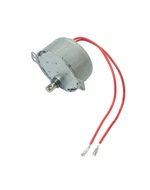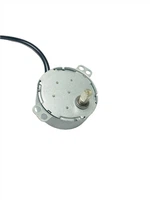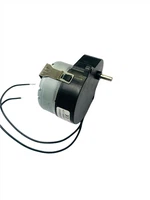Hysteresis Synchronous Motor
Why Choose Us
Our certifications
The Taiwan factory of our company has passed the ISO9002 international quality system certification, the American standard UL quality certification, the European standard CE /EMC quality certification, and the RoHs environmental protection certification.
Have import and export rights
The domestic company has the right to import and export, and its products are exported to more than 30 countries, and it provides the most suitable motors and related technologies according to the different needs of customers.
Our products
Our company produces synchronous motors, bidirectional synchronous motors, hysteresis motors (HTS), sparrow machine motors, and powder metallurgy gears. DC brushless motors, planetary geared motors (LED UV), push rod motors, DC motors, DC geared motors, high self-made products, and continuously improve equipment quality production management to achieve more rapid and flexible services.
Our service
In order to meet customer requirements for product diversification, the company also imports Japanese Mabuchi motors as an agent, and 100% of the goods are picked up by Mabuchi warehouses, and can be delivered in Hong Kong and domestically.
A Hysteresis Synchronous Motor is an electrical device where the input is given in the electrical form like current or voltage and the output obtained is in the mechanical form like torque or force. Electric motors are classified into two types namely DC motors like Brushless & Brushed and AC motors like synchronous AC motor and Asynchronous AC motor. Synchronous motors are classified into two types like Nonexcited (Reluctance & Hysteresis) and Direct Current Excited. Asynchronous AC motors are Induction and Commutator. A hysteresis motor is a subclassification of synchronous motor, these motors are mainly used in a noiseless operating environment with constant speed.
Benefits of Hysteresis Synchronous Motory
Simple Structure: The hysteresis motor has a straightforward design with no complicated winding arrangements, making it easy to manufacture and maintain.
Easy Start-up: Due to the inherent hysteresis torque, these motors can start without the need for any additional starting devices.
Low Noise: The motor operates quietly due to the absence of windings and brushes, which are common sources of noise in other types of motors.
Reliable Operation: Hysteresis motors have a robust and durable construction, leading to dependable and long-lasting performance.
High Mechanical Strength: The rotor's ferromagnetic material provides excellent mechanical strength, making it suitable for high-speed operations.
Synchronous Operation: Once started, the motor can synchronize and stably operate at the synchronous speed.
Low Electromagnetic Noise: The absence of windings and brushes reduces electromagnetic interference and noise.
Small Starting Current: Hysteresis motors require a low starting current, making them suitable for applications with limited power availability.
Types of Hysteresis Synchronous Motory
Wound Rotor Synchronous Motor
Wound rotor synchronous motors are the most traditional type of synchronous motor, widely used in various types of industrial applications. The defining feature of this synchronous motor is its rotor construction. Unlike other types of synchronous motors, its rotor contains wound field wire coils made up of copper wire. These coils are wound around the rotor core. When these coils are energised, it creates an electromagnet. The rotor also includes slip rings, which are connected to these windings and allow for DC supply to the field coils.
Permanent Magnet Synchronous Motor
Permanent magnet synchronous motor represents a significant advancement in electric motor technology. These motors have gained popularity across various industries due to their unique design and operational benefits such as high efficiency with excellent performance.Unlike other synchronous motors that use electromagnets, permanent magnet synchronous motors use permanent magnets on the rotor. These magnets are made up of high-strength rare earth materials such as neodymium or samarium-cobalt. These magnets create a strong magnetic field without the need for external excitation.
Reluctance Synchronous Motor
Reluctance synchronous motor is a unique and important type of synchronous motor. This motor operates on a principle distinct from other types of synchronous motors, which depend on magnetic reluctance to generate torque and movement. The construction of a reluctance synchronous motor is characterised by its rotor design. Unlike other synchronous motors that use wound coils or permanent magnets in the rotor, the rotor of reluctance synchronous motor is made up of magnetically soft materials such as iron. It features a silent pole structure, with alternating regions of high and low reluctance.
Application of Hysteresis Synchronous Motory
Valve Control
Hysteresis motors find typical applications in controlling valve systems, especially in scenarios where precise and constant speed control is required.
Medical Devices
Hysteresis motors are employed in certain medical devices and equipment, thanks to their low noise and precise speed control capabilities.
High Inertia Loads
Due to their large starting torque and constant torque characteristics, hysteresis motors are well-suited for driving loads with high rotational inertia.
Precision Machinery
They are commonly used in precision machinery and equipment, where stable and reliable operation is crucial.
Instrumentation And Control
These motors are often used in various instruments and control systems, such as electric clocks and other timing devices.
Optical Equipment
Certain optical devices and equipment benefit from the quiet and smooth operation of hysteresis motors.
Permanent Magnet Synchronous Motor Vs Hysteresis Synchronous Motor
Magnetic field generation
Permanent magnet synchronous motors use permanent magnets as magnetic field sources, and these permanent magnets are usually embedded in the rotor of the motor to produce a stable magnetic field. In contrast, hysteresis synchronous motors generate a magnetic field through an energized coil, which forms a magnetic field when energized and gradually weakens after power failure. This difference determines how they work and their performance characteristics.
Features
Permanent magnet synchronous motor has the characteristics of high efficiency, high power factor and high control precision. Its constant magnetic field allows it to provide stable performance over a wide range of loads and is suitable for applications requiring efficient energy conversion and precise control. These characteristics make permanent magnet synchronous motors ideal for electric vehicles, industrial drives and wind power.In contrast, the performance of hysteresis synchronous motors may be excellent in some specific load ranges, but may be unstable at high loads. Hysteresis phenomenon may lead to performance variation, which requires targeted control strategies to deal with.


Applications
Permanent magnet synchronous motor is widely used in different fields. In electric vehicles, permanent magnet synchronous motors provide powerful power and long driving range for vehicles with their high efficiency and high power factor. In industrial drives, they are able to efficiently convert electrical energy into mechanical energy for various mechanical operations. In addition, permanent magnet synchronous motors are also used in wind power systems to promote the use of renewable energy by efficiently converting wind energy into electricity.The application of hysteresis synchronous motors is relatively few, usually limited to some special requirements of the scene. For example, in some laboratory studies, it may be necessary to adjust the strength of the magnetic field or explore the properties of the hysteresis phenomenon.
Advantages
The advantages of permanent magnet synchronous motor are its high efficiency, high power factor and high control accuracy. Thanks to the constant magnetic field, they provide stable performance under various load conditions, helping to reduce energy consumption and improve work efficiency. In addition, they are suitable for a wide range of applications, which have a positive impact on the development of modern industry and transportation.Although hysteresis synchronous motors may exhibit good performance within a specific load range, their application is limited due to their instability. Therefore, compared with permanent magnet synchronous motor, hysteresis synchronous motor has relatively few advantages.
How to Choose Hysteresis Synchronous Motory
Current
Current powers the motor, and too much current will damage the motor. For DC motors, operating and stall currents are important. Operating current is the average amount of current the motor is expected to draw under typical torque. Stall current applies enough torque for the motor to run at stall speed or 0RPM. This is the maximum amount of current the motor should be able to draw and the maximum power when multiplied by the rated voltage - keep this in mind during motor selection. Heat sinks are important because they are constantly running the motor or are running it at higher than the rated voltage to keep the coils from melting.
Voltage
Voltage is used to keep the net current flowing in one direction and to overcome the back current. The higher the voltage, the higher the torque. A DC motor's voltage rating indicates the most efficient voltage while running. Be sure to apply the recommended voltage. If you apply too few volts, the motor will not work, whereas too many volts can shorten windings, resulting in power loss or complete destruction.Operating and stall values also need to be considered with torque. Operating torque is the amount of torque the motor was designed to give, and stall torque is the amount of torque produced when power is applied from stall speed. When it comes to motor selection, you should always look at the required operating torque, but some applications will require you to know how far you can push the motor. For example, with a wheeled robot, good torque equals good acceleration, but you must make sure the stall torque is strong enough to lift the weight of the robot. In this instance, torque is more important than speed.
Velocity
Velocity, or speed (RPM), can be complex regarding motors. The general rule is that motors run most efficiently at the highest speeds, but this is not always possible if gearing is required. Adding gears will reduce the efficiency of the motor, so take into account speed and torque reduction as well when comparing motor selections for your unique applications.
Consider Your Needs
These are the basics to consider while selecting a motor. Consider an application's purpose and which current it uses to select the appropriate type of electric motor. An application's specifications, such as voltage, current, torque, and velocity, will determine which motor is most appropriate, so be sure to pay attention to its requirements.
Working Principle of Hysteresis Synchronous Motor
A synchronous motor is a type of alternating current (AC) motor that works on the principle of electromagnetic fields. The working of a synchronous motor is divided into three stages: Excitation, synchronization, and steady-state operation.When a 3-phase supply is connected to the stator winding, a rotating magnetic field is produced by the stator. It rotates at a synchronous speed. Exciter produces DC voltage which is supplied through brushes and slip-rings to the field winding of the rotor. Thus rotor poles are formed.
Similar poles try to repel each other and hence rotor poles are repelled by stator poles and the rotor tries to rotate in an anti-clockwise direction. Now, as the stator poles are also changing their position (rotating field), after the half revolution, the upper part of the stator will form an S pole and the N pole will be at the bottom. Meanwhile, the rotor's N pole reaches up to the bottom.
How to Maintain Hysteresis Synchronous Motory
Check the Hysteresis Synchronous Motor lubrication
Believe it or not, it's absolutely possible to overlubricate a Hysteresis Synchronous Motor, which can lead to internal problems. However, your motor needs lubricant to operate at peak performance level. Each electric Hysteresis Synchronous Motor requires different amounts of lubricant. That said, we would suggest checking the manufacturer's manual. The manufacturer can best provide the intervals and amounts of lubricant for their motor to operate at its best. Lubricating the motor too early or too late can result in premature wear and tear. Additionally, manufacturers typically recommend a specific lubricant that's designed for their motor. It's important to use the suggested lubricant; Otherwise, you could risk voiding a manufacturer's warranty.
Regularly Inspect The Bearings
The Hysteresis Synchronous Motor's bearings experience some of the most wear and tear, so it's only natural to expect them to cause issues from time to time. Much of the preventative measures you can take we've already discussed, such as general maintenance and keeping the motor clean. However, bearings can go bad for several other reasons. To avoid bearings wearing out earlier than they should, you first must assure the motor is aligned properly. Misalignment can significantly strain one or both of the bearings. Furthermore, improper lubrication can also cause your bearings to wear out sooner than they should. One common red flag that a bearing has gone bad is an overheating motor. Each Hysteresis Synchronous Motor has a different working temperature, so it's important to read the manufacturer's manual to find your motor's recommended temperature.
Reduce Or Eliminate Vibrations
Every Hysteresis Synchronous Motor is going to vibrate to some extent, but excessive vibration can cause serious damage––Potentially permanently––To your electric Hysteresis Synchronous Motor. The moment you notice your motor is vibrating more than usual, you should turn off the motor and find the source of the vibration. The source is usually a mechanical issue such as misalignment, a worn-out bearing, or belt tension that is too high. You could remove the belt and then do a test run to see if the motor is still vibrating. On the other hand, the cause of the problem could be your power source, which is a more serious concern. The bottom line is, in order to avoid excessive vibrations, you need to ensure proper alignment and that the bearings are in good condition.
Inspect The Rotor And Stator
Some call the rotor and stator “the heart of your motor,” and rightfully so. The rotor and stator are the essential components to the motor; If you take one of them away, you won't have an operating motor. You'll want to measure any gaps around these components and measure the diametrical clearance. The diametrical clearance measures free movement in the inner and outer race mounts. Your clearance can vary depending on your motor and the bearings.
Our Factory
Shenzhen Songgang Technology Industrial Co., Ltd. is a branch of Songgang International Group, headquartered in Hong Kong. It is a factory specializing in the production of various types of motors. There are factories in Taiwan and China to produce different types of motors.The Taiwan factory is the only metal gear synchronous motor professional manufacturer, adhering to the highest service level and best quality performance, serving domestic and foreign manufacturers. The domestic company has the right to import and export, and its products are exported to more than 30 countries, and it provides the most suitable motors and related technologies according to the different needs of customers.

certificate

















